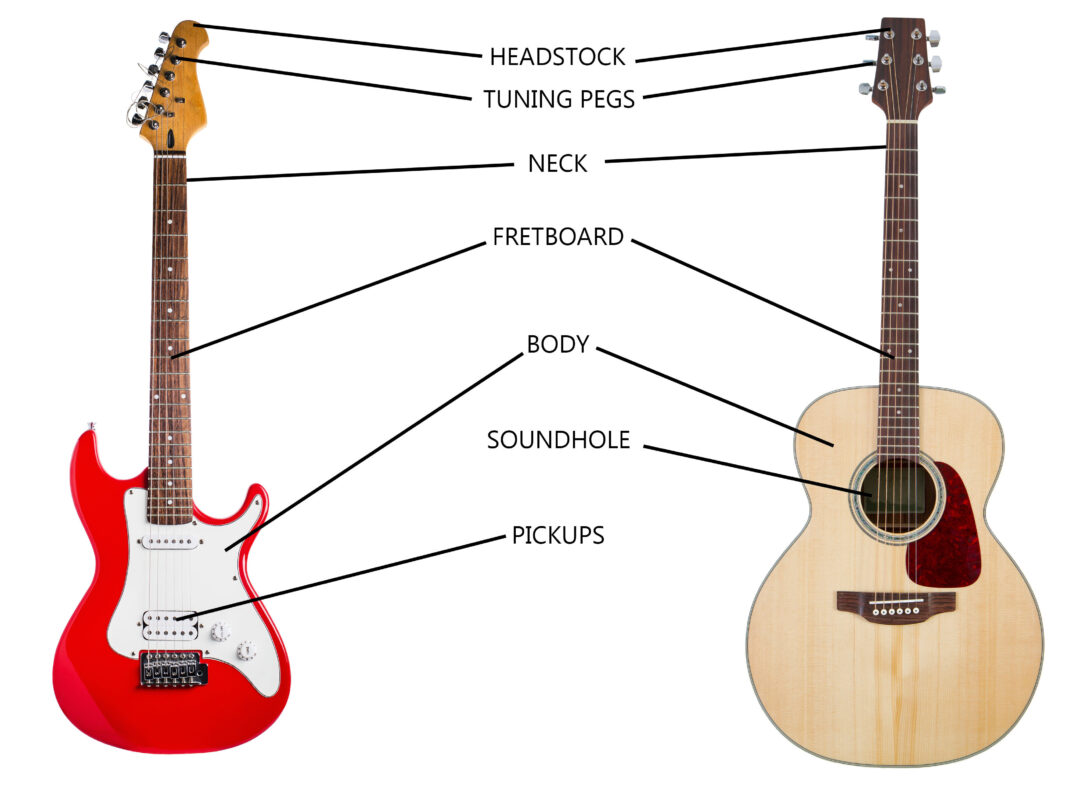A guitar is a beautiful and versatile musical instrument, year after year it captures countless musicians and music lovers. To truly appreciate and master this instrument, it’s important to understand its different parts and how they work together. After breaking down the various parts, pieces, and peculiarities you will have a deeper understanding of the anatomy of a guitar to help you master your instrument and enhance your appreciation for the art and science of guitar music.
Guitar Parts

The Headstock
Situated at the end of the neck, the headstock plays a vital role in maintaining the tension and tuning of the strings. It holds the tuning pegs, which are used to adjust the tension of the strings and achieve the desired pitch. If you are having an issue with an out of tune guitar, this is the section you will be working in to restore the proper pitch. The headstock’s design can vary, and it often showcases the brand logo or name of the guitar.
The Neck
The neck is the long, slender part of the guitar that connects the headstock and the body. It is typically crafted from wood and varies in length, width, and shape. The neck houses the fretboard, where the player presses the strings to produce different notes. Understanding the neck’s construction and characteristics is crucial for a comfortable playing experience.
The Tuning Pegs
Tuning pegs, also known as machine heads, are located on the headstock. These small, cylindrical components allow you to adjust the tension of each string individually. By turning the pegs clockwise or counterclockwise, you can raise or lower the pitch of the strings to achieve the desired tuning. Proper tuning is essential for producing pleasing and accurate sounds.
The Fretboard
The fretboard, also sometimes referred to as a fingerboard, is a flat surface attached to the neck, usually made of wood. It is divided into sections called frets, which determine the pitch of the notes produced when the strings are pressed against them. Typically, on the fretboard, there will be inlays or position marks usually found on the 3rd, 5th, 7th, 9th, and 12th frets. By pressing the strings against different frets, guitarists can produce a wide range of musical notes and create melodies and chords.
The Body
The body of a guitar is the main resonating chamber that amplifies the sound produced by the strings. It comes in various shapes and sizes, such as dreadnought, concert, or electric guitar bodies. The body’s construction and materials greatly influence the instrument’s tonal qualities and overall sound projection.
The Soundhole (Acoustic Guitars)
In acoustic guitars, the body features a soundhole. This circular opening allows the sound to escape and resonate, enhancing the instrument’s volume and tonal characteristics. The size and placement of the soundhole contribute to the guitar’s unique sound and projection.
The Pickups (Electric Guitars)
Unlike acoustic guitars, electric guitars have pickups. These electromagnetic devices are usually located beneath the strings and convert the string vibrations into electrical signals. The signals are then sent to an amplifier, which produces a louder sound. The type and configuration of pickups greatly impact the electric guitar’s tonal palette and versatility.
Understanding the different parts of a guitar is essential for players to develop a deeper knowledge of their instrument and improve their playing abilities. By grasping the anatomy of a guitar, musicians can make informed choices when selecting or customizing their instrument, optimize their playing techniques, and achieve their desired musical tones.
Whether you’re a beginner seeking to embark on your guitar journey or an experienced guitarist looking to refine your skills, visit Guitar Craft Academy for expert guidance and comprehensive training on guitar craftsmanship and playing techniques. Our team has combined decades of experience dedicated towards the art of guitar building and design and helping students for a lifelong journey of appreciating music.
